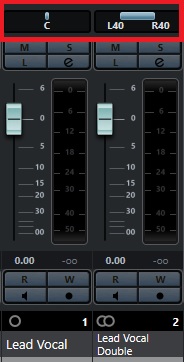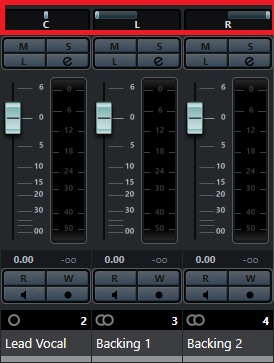If you’re still struggling with getting a vocal mix that is wide and exciting then this article will help you master the art of panning various types of vocals.
Getting the best stereo image balance for your vocals starts in the recording stage.
It’s very crucial to record all your vocal takes with panning in mind. That will help you avoid a lot of guesswork during mixing.
When you’re mixing a song that you didn’t record then you’ll need to get creative but there are a few guidelines that you can follow to ensure that you get the best results.
How To Pan Vocals
Listening to how the rest of the instruments are panned will also help with guiding you in the right direction.
The goal is to find the perfect sweet spot in the stereo field that is not dominated by other instruments.
Sometimes you just need to pan other instruments in the mix to create space for the voice to shine.
Always keep in mind that panning vocals is more of an art and not a science. This means there’s no right or wrong.
However, there are a few techniques you can use to make sure that you get amazing results.
Here are some of the guidelines.
How to Pan Lead Vocal Layers
How you pan lead vocal layers will be determined by their role in the song. Figure out if you want the other layers to help the main voice sound thick, wide, present, etc.
The number of layers will also define where each vocal take will be placed in the stereo field.
Hence it’s crucial to record with panning in mind so that you don’t have to guess.
Usually, if you have 2 takes of the lead vocal, the other take is used as a parallel track to add what’s missing on the main one.
This could be for increasing clarity, air, presence, etc. so in this case, you will keep them both in the center to get a fuller sound.
When you start recording 3 or more takes then that’s when you know that the other takes are for making the lead voice sound wider in the mix.
For instance, if there are 3 channels of the lead then one will remain in the center and the other 2 will be panned to the sides equally to make the voice sound big and wide.
When there are 4 takes (which is just insane) then one will be centered and the second one will be used as a parallel track to add warmth or whatever that’s missing on the main vocal.
The other remaining two will be spread out to give the vocal some width.
You can also get creative with the other vocal layer that’s being used as a parallel channel by making it a bit wider.
There are many techniques you can use to make it wide, this will reduce clutter in the center so that other sounds (kick, bass, snare, etc.) can become clearer.
How much you pan the layers is just a matter of taste and do what works best for the song, there are no rules. So you’ll need to trust your ears.
That’s how you pan lead vocal layers.

Harmony Vocals Panning Tricks
The number of layers will determine how the harmony vocals should be panned in a song. It’s always recommended to record vocal harmonies using even numbers (2, 4, 6, etc.).
This way it’s much easier to spread them in the stereo image.
Harmonies are usually used to support the lead vocal so that’s why they’re mostly panned to the sides so that the main voice can dominate the center.
The trick is to have them spread throughout the stereo field to make the voice sound full and wide in the mix.
If you keep them in the center they can cause a lot of clutter and prevent the main sounds (kick, bass, snare, etc.) to remain upfront and punchy.
The stereo image is also big enough for you to spread them to taste. Don’t have them dominate the same position, distribute them in different pockets.
Here’s a good example:
- Harmony 1: 100% left
- Harmony 2: 100% right
- Harmony 3: 70% left
- Harmony 4: 70% right
- Harmony 5: 50% left
- Harmony 6: 50% right
These numbers are just examples, you’ll need to listen to how the rest of the instruments are panned then make your decisions based on that.
You don’t want to end up with sounds that are fighting for the same space, spread everything so that no sounds are clashing for the same pocket.
Keep in mind that there needs to be a lead vocal track for you to pan the vocal harmonies.
If there’s no lead vocal then you’ll need to keep 1 or 2 harmonies in the center or else your vocals will fall flat when played in mono.

How to Pan Background Vocals
Background vocals are usually used to support the lead and emphasize certain phrases to have the listener singing along.
So when you’re panning background vocals it’s crucial to make sure that they don’t overpower the main voice or sound too far at the back of the mix.
Finding a good balance for the backings is crucial in a mix because messing up the balance can break a really good vocal performance.
The number of background vocal tracks you have in the song will also define how they should be panned.
For instance, if you have 2 takes then you simply pan each part left and right.
When there are 3 layers then you can keep one in the center and have the other ones sent to the sides.
Maybe even make the one in the center wider to make space for the lead.
You also have to listen to the tone, the one singing in the lowest octave is usually the one kept in the center and the higher tones are the ones panned to the sides.
If you have more than 3 layers then you’ll need to get creative and look at the other suggestions mentioned above (in the lead and harmonies section).
Try some of those techniques to see if they’ll work or not.
There are no set rules so you’ll need to get creative in most cases, just make sure that the stereo image is well balanced.
You don’t want to end up with a song that’s heavy on one side.

Wrap
The strategies mentioned above should help you tackle any type of situation. It doesn’t matter if you’re mixing chorus vocals or verse.
Even the genre doesn’t matter, it could be rap, jazz, folk, etc. they all have the 3 parts mentioned above (lead, harmonies, and backings).
Don’t get confused by terms such as Ad libs for instance.
If there’s a lead then you treat them like background vocals. If you have harmonies and Ad libs then you treat the Ad libs as the lead vocal.
The most important thing to keep in mind is that the lead is supposed to remain in the center, and then the rest of the vocals can be panned to make your vocals 3 dimensional (height, depth, and width).
Also, make sure that the stereo image is well-balanced. You can only pan a vocal if there’s a complimentary one to balance both sides.
This will help you avoid making one side heavier than the other.
When the stereo field is not balanced it will sound weird to the listener and ruin the experience.
Feel free to leave a comment below if any of this is confusing and I’ll get back to you.
Let me know if you’ve learned something new today, I love hearing from my blog readers because it keeps me going.